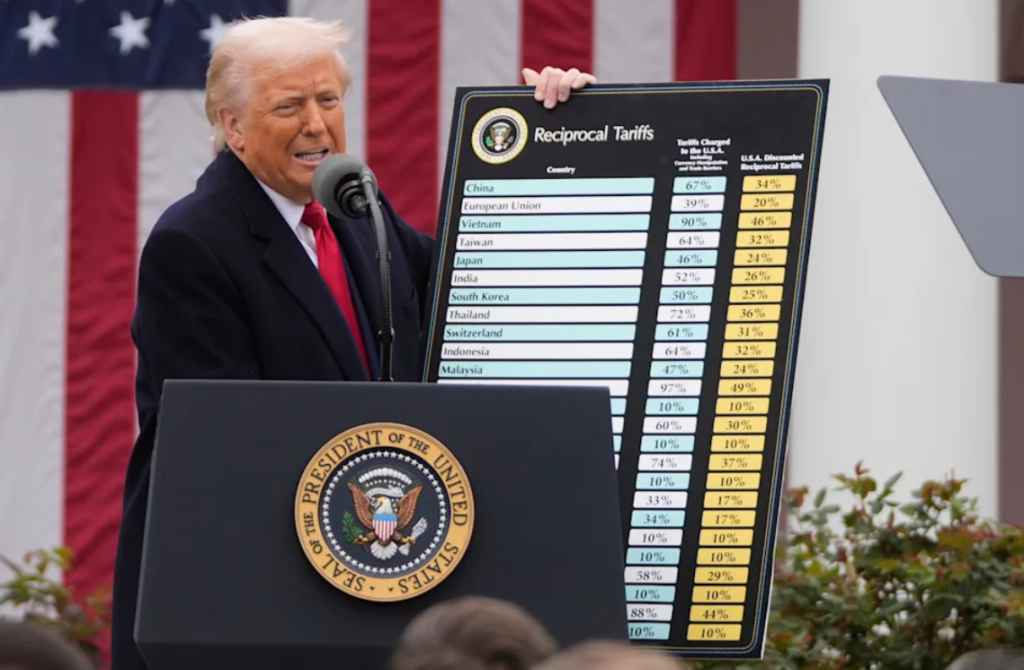
President Donald Trump has implemented one of the most aggressive tariff regimes in memory, an all-encompassing array of economic measures aimed at some of America’s biggest trading partners. In a decision that has roiled financial markets and sent tremors through international economic circles, the president announced massive increases in tariffs on major countries, including China, India, and the member countries of the European Union.
These actions are also compounded by a blanket 10% tariff that has been placed on all other countries not specifically cited in the initial announcement. But those aggressive tactics are aimed at “leveling the playing field” for American industries and pressuring foreign competitors to abide by rules that both his administration and American firms consider to be fairer, so many experts caution that the isolationist bent of these actions could have dire consequences for the world’s biggest economy.
This strategy is based on the belief that the imposition of large economic sanctions will lead to a renegotiation of longstanding trade deals, deals that, President Trump says, have benefited foreign partners at the expense of American interests for too long.
The European Union, the foundation of the global trading system for the better part of half a century, for instance, is now expected to suffer a 20 percent tax on its exports to the United States. China, which has been at the center of a growing trade dispute, is facing a cumulative increase in tariffs that now reaches 54 percent. These steps mark a significant break from decades of diplomacy and economic protocols, essentially upending the rulebook of international trade.
The policy, which President Trump highlighted during a high-profile address in the Rose Garden, was underscored by his assertion that “all countries” would be treated the same without exception, an announcement that triggered an immediate blanket 10 percent duty on countries not on the list for higher tariffs. This all-encompassing strategy is designed to make certain that no country can escape the new economic reality the president is set on making stick.
In the hours after this bombshell announcement, the international community tried to gauge what the resulting fallout might be. Leaders around the world started plotting how to respond to what many consider a sharp shift in U.S. trade policy.
British officials, for example, called for calm and a restrained response to the developing circumstances, even as talks about retaliatory action were being initiated. Likewise, leading European officials, such as the European Commission president, Ursula von der Leyen, warned that failure to negotiate mutually acceptable trade agreements would come at the cost of immediate and enduring countermeasures.
The expectation of this shock-along kind of strategy is wicked high. Supporters say those tariffs will put the brakes on trade imbalances while rejuvenating American industries, but critics warn that the policy could come at the cost of alienating allies and undermining decades-long economic ties. The world now waits to see whether this audacious gambit will make good on its promise of “Making America Wealthy Again” or whether it will recoil back on its rickety foundations, just as previous protectionist regimes have, revealing the same folly that has ensnared them.
What is Trump’s tariff plan?
When Treasury Secretary Scott Bessent appeared en masse at his confirmation hearings, he laid out a multi-pronged vision for President Trump’s tariff plan. On the one hand, the strategy was directly targeted at bolstering the American economy. This element of the plan was aimed at protecting jobs and growing industrial capacity in America by making American-made products more competitive in the global marketplace. The tariffs were also viewed as an opportunity to raise revenue that could be used to invest back into our families and businesses throughout the country.
But the plan also had a distinct geopolitical dimension. The goal was to bolster America’s position in the world by decreasing the nation’s reliance on foreign adversaries, a particularly sensitive issue in sectors tied to national security. In this telling, tariffs were not just economic instruments but tools of foreign policy, tools that could be used as economic sanctions in the service of the United States’ security needs.
But those lofty goals were not a direct target of President Trump’s tariff announcements in their early days. It was the first round of tariffs that was used as a bargaining chip in other intense negotiations, specifically, the debates over immigration and fentanyl, a potent synthetic opioid, entering the United States.
To put another spin on what was behind these maneuvers, Columbia University professor Brett House noticed that the White House’s method, one in which it imposed tailored tariffs against specific countries, as well as broad, blanket tariffs, seemed to reflect a conscious attempt at dominating the negotiating process.
As House explained, this approach essentially maneuvered every country into needing to negotiate alone with the administration. That, he said, was the sort of power play reflected in the kind of “you can pick your turkey” strategy deployed by a leader whose penchant for using the tactics of divide and conquer to undermine unified opposition helps perpetuate an autocratic style of leadership.
Decoding Tariff Secrets of Trade Regulations
Several economists, however, have a sharply different perspective, in part because the White House has explained how it is setting tariff rates. Under this particular methodology, the administration starts with the current goods trade deficit that already exists between the United States and another country.
That deficit, the difference between the value of what the U.S. purchases from that country and what it sells to that same country, is then weighed against the total value of goods purchased from that country. Essentially, this division gives us a number, and this number, divided by two, is the tariff rate. That process, although appearing straightforward, underscores the general strategy, which is to reduce what is perceived as America’s overdependence on international supply chains and foreign markets.
Joao Gomes, senior vice dean of research at the University of Pennsylvania’s Wharton Business School, further explained this approach by stating that the tariffs should not be seen solely as political theater or an expression of national pride. They are instead fundamentally about reshaping the relationship between economic agents.
The main purpose, according to him, is to face the trade gap, which is a wish to put right what many in his camp see as a ratty financial inequality. Gomes argues that when one deep dives into the numbers, it should become obvious that the administration seeks to remove these imbalances. He characterizes the trade deficit as a vulnerability, claiming that it drags on the economy and poses an existential threat, and that persistent lopsidedness undermines the nation’s economic security by making it too reliant on the global marketplace.
Furthermore, Gomes argues, as he does not necessarily agree with every part of this policy, knowing the economics behind it all is just another step to see how this all was intended to play out. The focus on basic economic principles, as opposed to vague political bluster or a desire to lash out at nationalism, gives the policy its level of predictability in which direction it will take.
In other words, it is emphasizing trade deficit reduction as a means to strengthen the national economy by decreasing counterparty risk for the U.S. economy, at least on paper, despite predictions of inflation rather than deflation, the central banks running out of options, or bombing foreign regions.
Has anything like this been done before?
For those who wonder whether what is going on today has any precedent in history, it turns out that in order to find any policy approach similar to the current White House mindset, they must literally turn the pages of history, nearly a century.
Amid the Great Depression in 1930, President Herbert Hoover signed the Smoot-Hawley Tariff Act, designed to protect American businesses and farmers from rough international competition. This law enacted high duties on foreign products, especially agricultural products, that were perceived to be underpricing U.S. prices in a time when the survival of the economy was in question and was meant to protect domestic producers.
Before Smoot-Hawley passed, economists observed, the average import tariff was about 35.7%. But in the wake of the law’s passage, this average increased to nearly 41.1%, a dramatic increase reflecting the protectionist instincts of the administration.
Something like that was done previously with the Fordney-McCumber Tariff Act of 1922, which raised tariffs from 21 percent to under 38.8 percent. The numbers, as calculated by, among others, the economist Douglas Irwin at Dartmouth, reflect the dependence on tariffs as a means of buttressing American industries during times of economic distress.
By comparison, the modern-day tariffs, the 10% tariff on British goods, for example, and the 20% tariff on imports from the European Union, seem modest. But the economic picture has changed significantly since then. In the 1920s and 1930s, only 1.3% to 1.4% of the nation’s gross domestic product (GDP) was attributable to imports.
Today, by contrast, globalization has changed trade relations, and those same policies now touch a far larger part of the economy. For example, by the end of 2025, even the earlier-announced tariffs (which targeted Canada, Mexico, and initially China) were assessed on imports that represent nearly 5% of America’s GDP.
Even if tariff rates now appear lower, that’s because they apply to a much wider range of goods. These moves also open themselves to retaliation in the form of tariffs from trade partners, the result of which could be an economic cycle that would be more disruptive and hurtful than the one experienced in the 1920s and 1930s.
The context is different: at that time, heavy tariffs were implemented in periods of painful economic decline, and were mostly reserved for a limited number of imports. The picture is completely different in today’s grotty policy landscape, where the economic effects of such measures are both wider and more complicated.
President Trump has even invoked the historical precedent of Smoot-Hawley to justify his administration’s tariff decisions. But critics including Wharton’s Gomes have rejected this comparison as “ridiculous,” contending that the conditions of the 1930s, characterized by a recession, the gold standard and a monetary policy aimed at protecting that standard and causing vicious deflation, are so fundamentally different from those of today’s economy that the analogy just does not hold.







